In today’s rapidly evolving business and legal landscape, the importance of collaboration and knowledge exchange between departments has never been more apparent. While traditionally separated by distinct roles and expertise, the integration of legal and scientific teams through cross-functional training has shown to be a transformative approach that drives innovation, fosters collaboration, and ultimately supports overarching business goals.
Historically, legal and scientific teams have operated within their own silos, focusing on specialized tasks and objectives. However, the complex interplay between legal regulations, intellectual property rights, and technological advancements necessitates a more integrated approach. By breaking down these silos, organizations can bridge the gap between legal and scientific perspectives, leading to a holistic understanding of challenges and opportunities.
Reversed Legal Clinic
While trainings can take various forms, for us, interactive workshops proved to be the most effective at enhancing collaboration and purposefully breaking down silos.
For lawyers, working with scientists may be challenging at first. Our brain is somewhat wired differently: we (lawyers) always prepare for the worst and hence assess situations accordingly, while – based on our experience – scientists genuinely believe that, in the end, things will work out fine so for them and putting things into a wider context does not always occur automatically.
That’s probably why in many organizations in-house counsels are regarded as “gatekeepers” – everything has to go through legal review. Being the last step in the process also means that we are often left out of the ideation or creative phase and get only involved at the end. From a process point of view, this might work well if the “end-product” needs little legal vetting with few tweaks to make, but when more fundamental legal concerns arise, the project might need to be stopped which can create frustration on both sides. Even more importantly, we are missing out on the opportunity for legal experts to gain a deeper understanding of scientific processes and the underlying science, while for scientists to grasp the potential legal implications of their work on the business. This exchange of knowledge would not only broaden individual skill sets but can cultivate a culture of mutual respect and collaboration.
To encourage more collaboration, increase effectiveness, and help gain a deeper understating of various fields of expertise, we tried a novel form of training we named “the reversed legal clinic.”
The basic idea was to invite scientists to a real-life practical legal assessment experience: allow them to put on a legal hat and assess science-related matters from a legal perspective.
We started the session with an expedited journey around the legal mind: explaining the foundations of legal thinking based on facts and the law. We discussed via simple and practical examples why context matters and how context interplays with facts and the law. Finally, we took a fun exercise on legal drafting, which created a delightful atmosphere in the audience, but even more importantly managed to bring across a very critical point: the importance of accurate records creation.
Then participants were divided into groups and had the opportunity to take a seat in our chair. Each team received an unfiltered real-life work product previously submitted for review to the legal department and their task was to prepare the legal assessment on them. The outcome was impressive. Many of the previously missed points and legal concerns were raised by the teams, they willingly applied their learnings from the preparatory session and made the right adjustments.
It also resulted in a shift in sentiment toward the importance of legal assessment. Many expressed gratitude for the efforts of the legal team and invited us since then to be part of their project planning from the very start. It surely helped our integration, and to break down some of the silos which hindered efficiency and collaboration between the teams.
Driving Innovation: The Intersection of Legal and Scientific Expertise
Innovation thrives at the intersection of diverse disciplines. By leveraging our combined expertise, professionals from both domains can explore new approaches, develop novel solutions, and push the boundaries of industry norms. Whether navigating complex regulatory landscapes, mitigating legal risks, or driving scientific research, the synergy between legal and scientific minds can lead to game-changing innovations.
In-house counsels are part of the business decision-making process in most companies, we see the outcome of our advice every day. We normally work within a larger legal team and our colleagues in various functions are our clients. But the reality is that resources are scarce and often we face tight deadlines, conflicting business priorities, and performing repetitive work. To increase effectiveness, we must enhance better collaboration with our colleagues in other functions and get rid of silos.
Ultimately, the success of any organization hinges on its ability to align disparate functions toward common business objectives. Fostering collaboration and setting a collective vision will enable professionals from both disciplines to leverage their complementary skills to drive sustainable growth, mitigate risks, and seize new opportunities.
By Barbara Kis-Tamas, Senior Counsel Global Communications, Philip Morris International

















